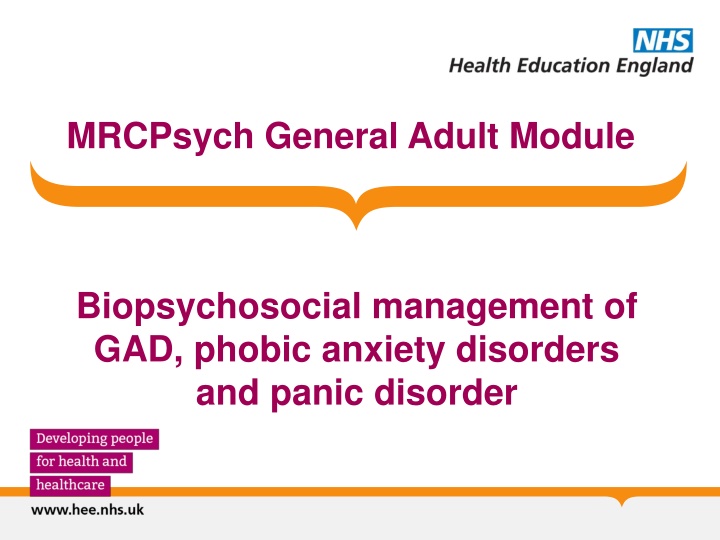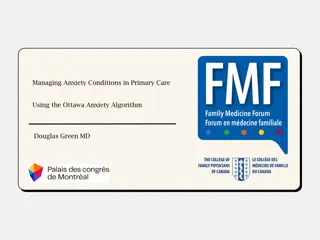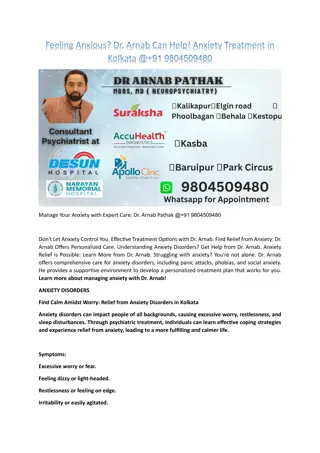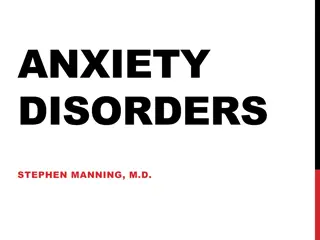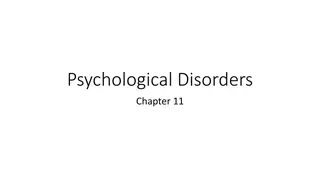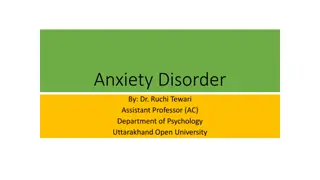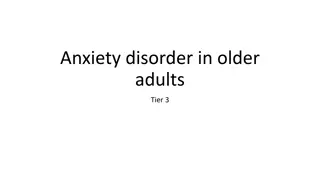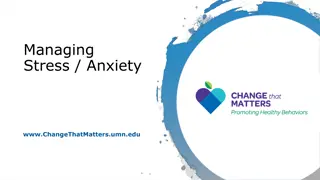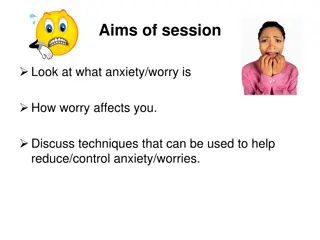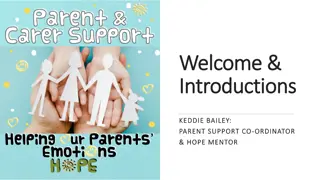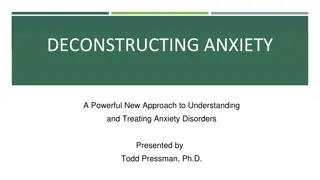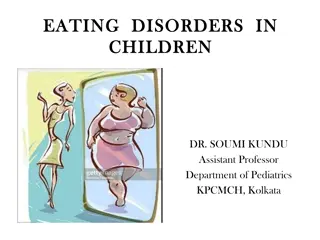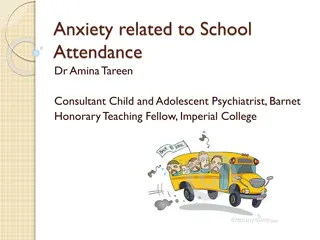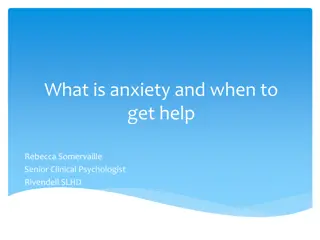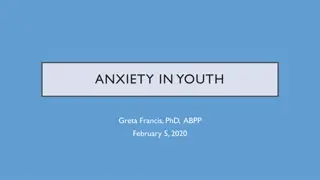Biopsychosocial Management of Anxiety Disorders in Adults
This module focuses on the biopsychosocial approach to managing generalized anxiety disorder (GAD), phobic anxiety disorders, and panic disorder in adults. Trainees will gain an overview of assessment, treatment strategies, including psychological and pharmacological interventions, and relapse prevention techniques. Topics covered include assessment of anxiety symptoms, management principles, stepped care models, and low-intensity psychological interventions.
Download Presentation

Please find below an Image/Link to download the presentation.
The content on the website is provided AS IS for your information and personal use only. It may not be sold, licensed, or shared on other websites without obtaining consent from the author.If you encounter any issues during the download, it is possible that the publisher has removed the file from their server.
You are allowed to download the files provided on this website for personal or commercial use, subject to the condition that they are used lawfully. All files are the property of their respective owners.
The content on the website is provided AS IS for your information and personal use only. It may not be sold, licensed, or shared on other websites without obtaining consent from the author.
E N D
Presentation Transcript
MRCPsych General Adult Module Biopsychosocial management of GAD, phobic anxiety disorders and panic disorder
GA Module: Anxiety Disorders Aims and Objectives The overall aim is for the trainee to gain an overview of the biopsychosocial management of anxiety By the end of the session trainees should: Develop an understanding of anxiety disorders and their management (pharmacological, psychological, social).
GA Module: Anxiety Disorders Expert Led Session Biopsychosocial management of GAD, phobic anxiety disorders and panic disorder
Outline Assessment Stepped care model Psychological treatments Drug treatments Course Relapse prevention
Management principles Correct diagnosis Co-morbidities Rule out organic e.g. thyroid etc. Effect of alcohol, substances and caffeine Over the counter and prescribed medications Psychoeducation, self-help Psychological interventions Medications
Stepped care approach (GAD) NICE 2015 Step4 inpatient/ CRHTT CBT +drug Treatment-refractory Step 3: High intensity CBT or drug Inadequate response to step 2 Step 2: Low intensity CBT, self-help and psychoeducational group If no improvement after education Step 1: Identification and diagnosis Education about treatment option
Step 1 Identification and Assessment :number, severity and duration of symptoms, the degree of distress and functional impairment Education: over-the-counter medications, preparations and their potential problems.
Step 2 Low-intensity psychological interventions: individual non-facilitated self-help individual guided self-help psychoeducational groups
Step 3 Individual high-intensity psychological intervention (HIPI): should be used as first line Drug treatment (discussed later)
Individual high-intensity psychological intervention (HIPI) Offer either CBT or applied relaxation CBT: based on the treatment manuals used in the clinical trials for CBT or applied relaxation for GAD delivered by trained and competent practitioners consist of 12 15 weekly sessions
General principles of prescribing in Anxiety disorders Severity of symptoms Co-morbidities SSRI - 1st line 12 weeks Additional medications
Drug treatment for GAD Antidepressants: SSRIs, SNRIs Pregabalin Other treatments: not licensed, weak evidence Antipsychotics (like Quetiapine): monotherapy/augmentation Beta blockers Imipramine and Trazadone Buspirone Agomelatine
Drug treatment Offer Sertraline first: cost-effective If sertraline is ineffective, offer an alternative SSRI or SNRI
Drug treatment Cannot tolerate SSRIs or SNRIs, consider offering Pregabalin (Caution: Street value around addiction) Benzodiazepine: during crises Not to offer antipsychotic in primary care
Secondary Care Marked functional impairment in conjunction with: risk of self-harm or suicide or significant comorbidity or physical health problems or self-neglect or an inadequate response to step 3 interventions
Step 4 Specialist assessment of needs and risks Treatments: Combinations of psychological and drug treatments Combinations of antidepressants Augmentation of antidepressants with other drugs Cautions: side effects, interaction
Panic Disorder Trigger Physical sensation of anxiety Thoughts-Images I am having heart attack Behaviour Escape the situation Avoid future trigger Feelings Anxiety terror ..etc Thoughts-Images That is confirm it- I really am dying
Panic Disorder Recognition and diagnosis: differentiate from panic attack Step 1 Treatment in primary care: CBT/SSRI OR TCAs / Self help. Bibilotherapy based-CBT Step 2 Review and consideration of alternative treatments Step 3 Review and referral to specialist mental health services: combination of CBT and medication Step 4 Care in specialist mental health services: review of medication, CBT by experienced therapist , support to carer. Referral to tertiary centre Step 5
Psychological Interventions CBT should be used Briefer CBT: around 7 hours in total with structured self-help materials
Drug treatment for Panic Disorder SSRIs: first line. Venlafaxine TCAs: imipramine or clomipramine Valproate (off license) Avoid Benzos, propranalol and buspirone
Phobic Disorder Psychological interventions: Individual CBT CBT-based supported self-help Medication: escitalopram or sertraline deluxetine phenelzine is of proven efficacy (Social phobia : Most SSRI and Venlafaxine, moclobemide, pregabaline and gabapentin and olanzapine) Short-term psychodynamic psychotherapy: if decline CBT and medications
Social Phobia : The Heimberg Model Individual CBT education about social anxiety cognitive restructuring graduated exposure examination and modification of core beliefs relapse prevention
Social Phobia : Short- Term Psychodynamic Psychotherapy modify insecure attachments focus on a core conflictual relationship theme focus on shame encouraging exposure to feared social situations self-affirming inner dialogue improve social skills.
Social Phobia : Treatment Resistance Individual CBT in combination with antidepressant Escitalopram or sertraline There is emerging evidence for the efficacy of venlafaxine phenelzine
Evidence Base for SSRIs in Anxiety Disorders
Other Medications Benzodiazepines: Acute treatment Pregabaline: Acute treatment and relapse prevention of GAD and social anxiety. Role of Augmentation of SSRI/SNRI in GAD Agomelatine: Depression and GAD Buspirone: Acute treat of GAD and more effective in patients not exposed to BDZs, safe.
Continuation of Medication for Relapse Prevention GAD: 6-12 months Social phobia: At least 6 months PTSD: Up to 12 months OCD: At least 12 months
Factors Predicting a Good Outcome Having a stable, supportive family life Being young male Having no co-morbid physical illness Not receiving any psychotropic medication earlier in the course of illness
References Baldwin DS, Anderson IM, Nutt DJ, Allgulander C et al, Evidence-based pharmacological treatment of anxiety disorders, post-traumatic stress disorder and obsessive-compulsive disorder: A revision of the 2005 guidelines from the British Association for Psychopharmacology Journal of Psychopharmacology 2014; 1 37. British Association for Psychopharmacology - treatment of Anxiety disorders guidelineshttp://www.bap.org.uk/pdfs/Anxiety_Disorder_Guidelines.pdf5. Bruce SE, Yonkers KA, Otto MW et al. Influence of Psychiatric Comorbidity on Recovery and Recurrence in Generalized Anxiety Disorder, Social Phobia, and Panic Disorder: A 12-Year Prospective Study Am J Psychiatry 2005;162:1179-1187 Christmas D, Davies S, Nutt D. Psychopharmacology of anxiety disorder, Ebrainjnc.cpm Naomi A. Fineberg , Brigitte Tonnoir , Ole Lemming , Dan J. Stein. Escitalopram prevents relapse of obsessive-compulsive disorder. European Neuropsychopharmacology (2007) NICE Guidelines- GAD and panic disorder (Quick reference) http://www.nice.org.uk/nicemedia/live/13314/52601/52601.pdf3. Taylor, Paton, Kapur (2009). The Maudsley Prescribing guidelines, 10th Edition, Informa Healthcare.
GA Module: Anxiety Disorders MCQ 1. Venlafaxine is not licenced for which of the following indications? A B PTSD C Panic disorder D Depression +/- Anxiety E GAD Social anxiety
GA Module: Anxiety Disorders MCQ 1. Venlafaxine is not licenced for which of the following indications? A B PTSD C Panic disorder D Depression +/- Anxiety E GAD Social anxiety
GA Module: Anxiety Disorders MCQ 2. The following are TRUE of the pharmacokinetics of benzodiazepines: A When long-acting they have long elimination half-life. B When short-acting they have a small distribution volume. C When long-acting they have no active metabolites D When short-acting they have high accumulation E Benzodiazepines with a half-life of 12 hours tend to be used as anxiolytics.
GA Module: Anxiety Disorders MCQ 2. The following are TRUE of the pharmacokinetics of benzodiazepines: A When long-acting they have long elimination half-life. B When short-acting they have a small distribution volume. C When long-acting they have no active metabolites D When short-acting they have high accumulation E Benzodiazepines with a half-life of 12 hours tend to be used as anxiolytics.
GA Module: Anxiety Disorders MCQ 3. Which of the following statements is FALSE about the effects of hypnotics on sleep? A Benzodiazepines supress stage IV sleep. B With chronic Benzodiazepines use suppression of REM sleep in the early part of the night occurs C On withdrawal of Benzodiazepines a rebound increase above the normal amount of REM sleep occurs. D It may take up to 6 weeks to see a return to a normal sleep pattern on Benzodiazepine withdrawal. E Barbiturates are more likely to suppress REM sleep than are Benzodiazepines.
GA Module: Anxiety Disorders MCQ 3. Which of the following statements is FALSE about the effects of hypnotics on sleep? A Benzodiazepines supress stage IV sleep. B With chronic Benzodiazepines use suppression of REM sleep in the early part of the night occurs C On withdrawal of Benzodiazepines a rebound increase above the normal amount of REM sleep occurs. D It may take up to 6 weeks to see a return to a normal sleep pattern on Benzodiazepine withdrawal. E Barbiturates are more likely to suppress REM sleep than are Benzodiazepines.
GA Module: Anxiety Disorders MCQ 4. With regards to the NICE guidelines for GAD, which of the following is FALSE? A SSRIs (particularly Sertraline) are the first line medications. B SNRIs are second line. C If the patient cannot tolerate SSRI or SNRI, offer Pregabalin. D Antipsychotic should be offered for the treatment of GAD in primary care. E Do not offer a benzodiazepine for the treatment of GAD in primary or secondary care except as a short-term measure during crises
GA Module: Anxiety Disorders MCQ 4. With regards to the NICE guidelines for GAD, which of the following is FALSE? A SSRIs (particularly Sertraline) are the first line medications. B SNRIs are second line. C If the patient cannot tolerate SSRI or SNRI, offer Pregabalin. D Antipsychotics should be offered for the treatment of GAD in primary care. E Do not offer a benzodiazepine for the treatment of GAD in primary or secondary care except as a short-term measure during crises
5. With respect to the NICE guidelines for psychological intervention for GAD, which of the following is FALSE? A CBT for people with GAD should be based on the treatment manuals used in the clinical trials of CBT for GAD. B CBT for GAD usually consist of 12 15 weekly sessions (fewer if the person recovers sooner; more if clinically required), each lasting 1 hour. C Practitioners providing high-intensity psychological interventions for GAD need not have regular supervision to monitor fidelity to the treatment model. D If a person with GAD chooses a high-intensity psychological intervention, offer either CBT or applied relaxation. E Consider providing all interventions in the preferred language of the person with GAD if possible.
5. With respect to the NICE guidelines for psychological intervention for GAD, which of the following is FALSE? A CBT for people with GAD should be based on the treatment manuals used in the clinical trials of CBT for GAD. B CBT for GAD usually consist of 12 15 weekly sessions (fewer if the person recovers sooner; more if clinically required), each lasting 1 hour. C Practitioners providing high-intensity psychological interventions for GAD need not have regular supervision to monitor fidelity to the treatment model. D If a person with GAD chooses a high-intensity psychological intervention, offer either CBT or applied relaxation. E Consider providing all interventions in the preferred language of the person with GAD if possible.
GA Module: Anxiety Disorders Any Questions? Thank you.
